The Intel SSD 600p (512GB) Review
by Billy Tallis on November 22, 2016 10:30 AM ESTRandom Read Performance
The random read test requests 4kB blocks and tests queue depths ranging from 1 to 32. The queue depth is doubled every three minutes, for a total test duration of 18 minutes. The test spans the entire drive, which is filled before the test starts. The primary score we report is an average of performances at queue depths 1, 2 and 4, as client usage typically consists mostly of low queue depth operations.
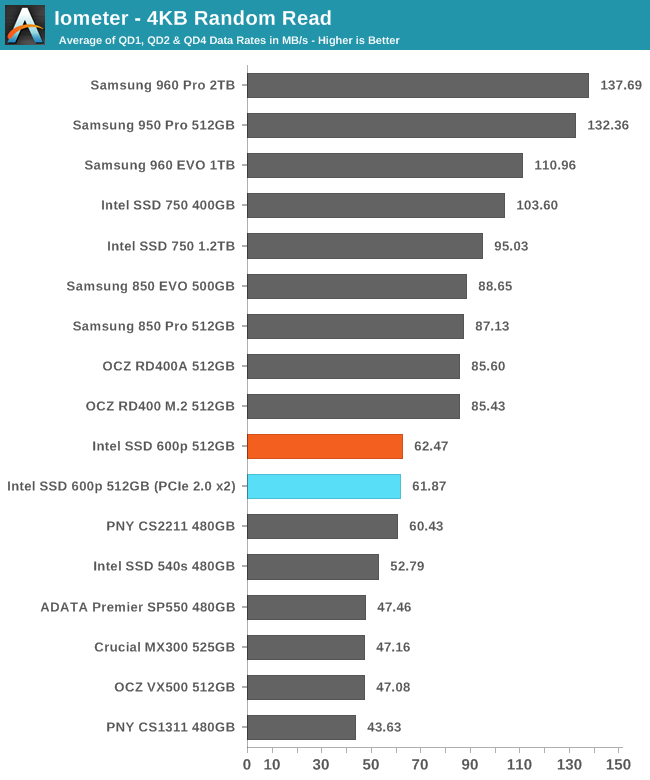
The Intel 600p has faster random reads than budget SATA SSDs, but it is significantly behind the Samsung 850 EVO.
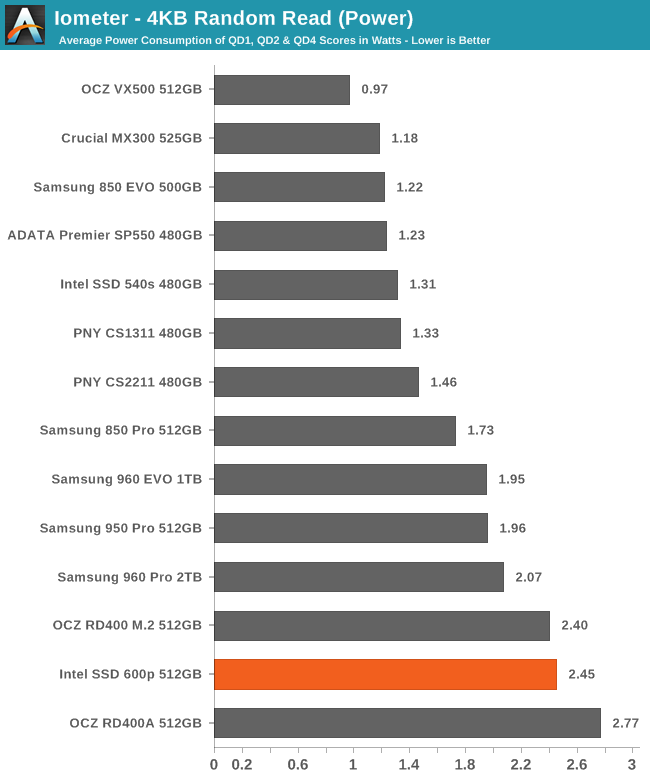
As usual, the 600p's power consumption is high, but not egregiously so: 2.45W is usually not high enough for thermal throttling to be a concern for M.2 SSDs.
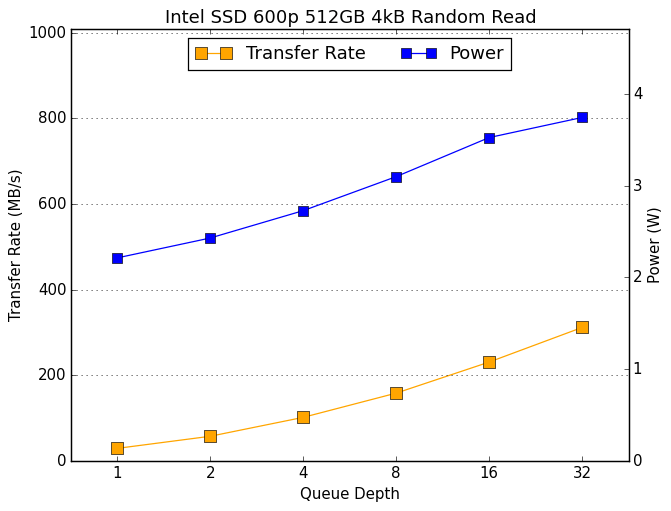 |
|||||||||
The 600p's performance grows slowly as queue depth increases, and even at QD32 it has not reached the SATA speed limit that Samsung's SATA drives hit at QD16.
Random Write Performance
The random write test writes 4kB blocks and tests queue depths ranging from 1 to 32. The queue depth is doubled every three minutes, for a total test duration of 18 minutes. The test is limited to a 16GB portion of the drive, and the drive is empty save for the 16GB test file. The primary score we report is an average of performances at queue depths 1, 2 and 4, as client usage typically consists mostly of low queue depth operations.
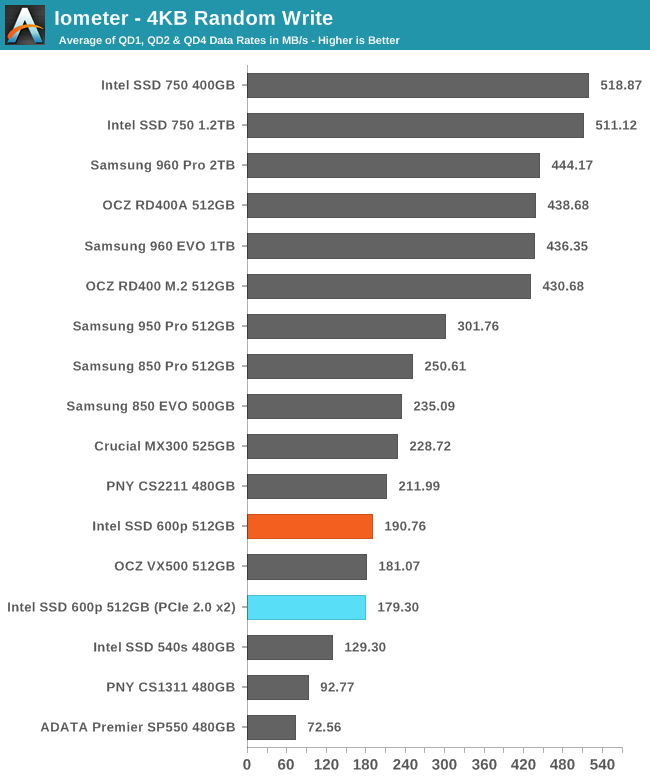
The 600p had above-average steady-state QD32 random write performance, but this shorter test of low queue depths puts the 600p only barely ahead of the slowest MLC SSD in this collection.
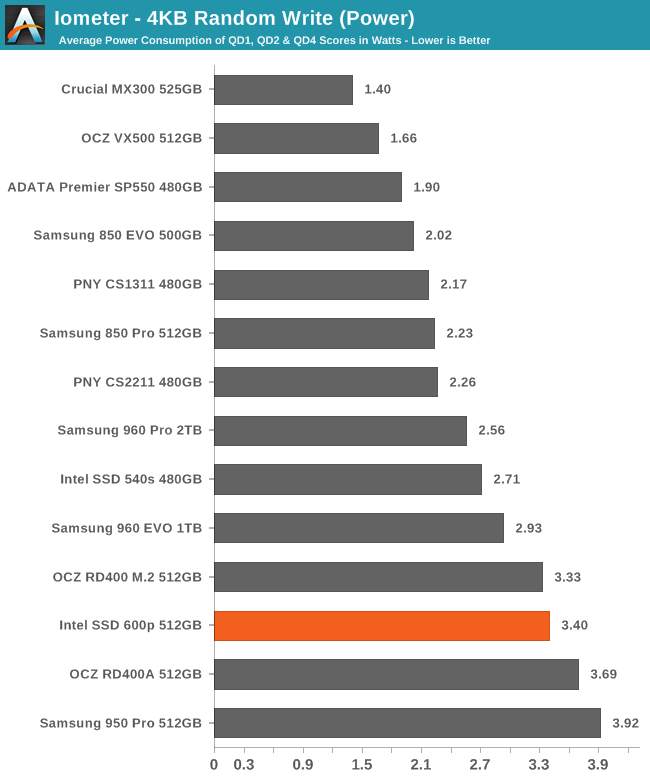
The 600p uses more power than most drives, but unlike the Samsung 950 Pro it isn't brushing up against the practical TDP limits of the M.2 form factor even at lowest queue depths.
 |
|||||||||
It is clear that the 600p's random write performance improves from QD1 to QD2, but after that all we're seeing in this graph is the same steady state variations we saw in the hour-long QD32 consistency test, potentially with some thermal throttling.










63 Comments
View All Comments
ddriver - Tuesday, November 22, 2016 - link
A fool can dream James, a fool can dream...He also wants to live in a really big house made of cards and bathe in dry water, so his hair don't get wet :D
Kevin G - Wednesday, November 23, 2016 - link
Conceptually a PCIe bridge/NVMe RAID controller could implement additional PCIe lanes on the drive side for RAID5/6 purposes. For example, 16 lanes to the bridge and six 4 lane slots on the other end. There is still the niche in the server space where reliability is king and having removable and redundant media is important. Granted, this niche is likely served better by U.2 for hot swap bays than M.2 but they'd use the same conceptual bridge/RAID chip proposed here.vFunct - Wednesday, November 23, 2016 - link
> However WHY would you want to do that when you could just go get an Intel P3520 2TB drive or for higher speed a P3700 2TB drive.Those are geared towards database applications (and great for it, as I use them), not media stores.
Media stores are far more cost sensitive.
jjj - Tuesday, November 22, 2016 - link
And this is why SSD makers should be forced to list QD1 perf numbers, it's getting ridiculous.powerarmour - Tuesday, November 22, 2016 - link
I hate TLC.Notmyusualid - Tuesday, November 22, 2016 - link
I'll second that.ddriver - Tuesday, November 22, 2016 - link
Then you will love QLCBrokenCrayons - Wednesday, November 23, 2016 - link
I'm not a huge fan either, but I was also reluctant to buy into MLC over much more durable SLC despite the cost and capacity implications. At this point, I'd like to see some of these newer, much more durable solid state memory technologies that are lurking in labs find their way into the wider world. Until then, TLC is cheap and "good enough" for relatively disposable consumer electronics, though I do keep a backup of my family photos and the books I've written...well, several backups since I'd hate to lose those things.bug77 - Tuesday, November 22, 2016 - link
The only thing that comes to mind is: why, intel, why?milli - Tuesday, November 22, 2016 - link
Did you test the MX300 with the original firmware or the new firmware?